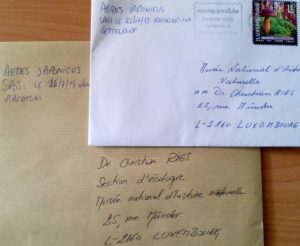We kindly ask the Luxembourg population to participate in the surveillance of invasive alien mosquitoes, which are quite easily recognised as they all are tiger mosquitoes with white sections on their legs.[ref]By the way, among the 27 indigenous mosquito taxa in Luxembourg, 4 are tigered, too: Aedes annulipes, Aedes cantans, Aedes vexans and Culiseta annulata.[/ref]
Table of contents
Catch a mosquito
Alive: it is quite easy to catch a mosquito with an empty large marmalade glass. After the catch, close the glass and put it in a deep freezer for one hour or overnight, which will kill the mosquito without destroying it. If the specimen is in good condition the Museum will be able to include it in its collections.
Dead: The mosquito can be killed with a fly swatter or a newspaper.
Send a mosquito
 Please write the following information on a piece of paper:
Please write the following information on a piece of paper:
- Your name
- Your phone number and /or email address (to enable us to contact you)
- Location / address of the catch
- Type of environment (eg. in a house, outside/near the house, on the street, in the garden, in a forest …)
- Date and time of the catch
Please insert the dead mosquito(-es) in a small plastic bag and put it together with the paper in an envelope and send it to the National Museum of Natural History to the following address:
Dr. Alexander Weigand
Recherche & collections
Musée national d’histoire naturelle
25, rue Münster
L-2160 Luxembourg
What will happen with your data?
The mosquito specimen that you submit to us will be identified and you will receive an email naming the species you caught.
After validation, your observation will be entered in the Museum database Recorder-Lux and automatically to GBIF. It will also be used as part of the MosquitoLUX project thus contributing to the production of an up-to-date checklist and atlas of the mosquitoes of Luxembourg.
EU wide co-operation
The National Museum of Natural History is representing Luxembourg in two COST actions:
The main aim of Aedes Invasive Mosquito (AIM) COST Action is to establish a transboundary network of partners and institutions across Europe to cost effectively address the management of the risk of introduction and spread of Exotic Invasive Aedes Mosquito Borne Viruses (EIAMBVs).
Alien-CSI, which addresses multidisciplinary research questions in relation to developing and implementing Citizen Science; advancing scientific understanding of Alien Species dynamics while informing decision-making, specifically implementation of technical requirements of relevant legislation such as the EU Regulation 1143/2014 on Invasive Alien Species.
In the frame of Working Group 1 on “Engaging People in Citizen Science”, the Citizen Science part of the Mosquito-Lux project was listed in the database of AS-related CS (Task 1). Our Luxembourg experience will also contribute to the review of needs, motivations and attitudes towards AS and CS (Task 2).
Page content last updated on 2023-06-21. Last proofread by Caroline Grounds on 2019-11-06.



